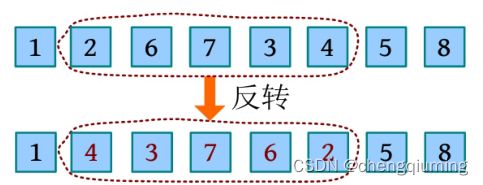玩链子游戏
一 游戏描述
有一条链子,上面有 n 颗钻石,钻石编号为 1~n 。可以对该链子执行两种操作:
① CUT a b c (区间切割操作)
切下从第 a 颗钻石到第 b 颗钻石的链子,把它插在剩余链子的第 c 颗钻石后面;比如 n 等于8,链子是 1, 2, 3, 4, 5, 6, 7, 8,对该链子执行 CUT 3 5 4,会切下 3, 4, 5 链子,剩下 1, 2, 6, 7, 8 链子,把 3, 4, 5 链子插入第 4 颗钻石之后,现在的链子是 1, 2, 6, 7,3, 4, 5, 8;
② FLIP a b (区间反转操作)
切下从第 a 颗钻石到第 b 颗钻石的链子,把链子倒过来放回原来的位置,比如在链子 1, 2,6, 7, 3, 4, 5, 8 上执行 FLIP 2 6,则得到的链子是1, 4, 3, 7, 6,2, 5, 8。那么执行 m 种操作后,链子的外观是怎样的呢?
二 输入
输入包括多个测试用例,在测试用例的第 1 行都输入两个数字 n 和 m(1≤n ,m≤3×10^5 ),分别表示链子的钻石总数和操作次数。接下来的 m 行,每行都输入 CUT a b c 或者 FLIP a b 。CUT a b c 表示切割操作,1≤a≤b≤n,0≤c≤n-(b-a +1);FLIP a b 表示反转操作,1≤a 对每个测试用例,都输出一行 n 个数字,第 i 个数字是链子上第 i 颗钻石的编号。 8 2 CUT 3 5 4 FLIP 2 6 -1 -1 1 4 3 7 6 2 5 8 本游戏包括区间切割(CUT a b c )、区间反转(FLIP a b)两种操作。这里以输入测试用例“8 2”进行分析,过程如下。 切下从第 3 颗钻石到第 5 颗钻石的链子,把它插入剩余链子上第4颗钻石的后面。 切下从第 2 颗钻石到第 6 颗钻石的链子,把它倒过来放回原来的位置。 1 创建伸展树,因为要进行区间操作,因此增加两个虚节点。 2 根据读入的信息,判断是执行区间切割操作还是区间反转操作。 3 按照中序遍历,输出伸展树。 数据序列为 1, 2, 3, 4, 5, 6, 7, 8,创建伸展树时在序列的首尾增加两个虚节点,该节点的值为无穷小 -inf,无穷大 inf(inf 是一个较大的数,如 0x3f3f3f3f)。由于在序列前面添加了一个虚节点,所以原来的位序增加 1,因此对 [l , r ]区间的操作变为对 [++l ,++r] 区间的操作。 首先切割 [l , r] 区间,将 Al-1 旋转到根,然后将Ar +1 旋转到 Al -1 的下方,此时切割的 [l , r ] 区间是 Ar +1 的左子树,用 tmp 暂存。然后查找第 pos 个节点,可以将 Apos 旋转到根部,再将 Apos+1 旋转到 Apos 下方,将 tmp 挂接在 Apos+1 的左子树上即可,相当于将 [l,r ] 区间插入第 pos 个节点之后,如下图所示。 CUT 3 5 4:因为添加了虚节点,因此切割 [4, 6] 区间,将其插入剩余区间第 5 个节点的后面。将第 3个节点(数字2)旋转到根,然后将第 7 个节点(数字6)旋转到第 3 个节点的下方,此时切割的区间就是第 7 个节点的左子树,用 tmp 暂存。 然后将第 5 个节点旋转到根部,将第 6 个节点旋转到其下方,将 tmp 挂接在第 6 个节点的左子树上即可,此时序列为1, 2, 6, 7, 3, 4, 5,8,如下图所示。 和区间切割类似,反转 [l , r] 区间时只需将 Al-1 旋转到根,然后将 Ar +1 旋转到 Al-1 的下方,此时需要反转的 [l , r ] 区间就是 Ar+1 的左子树,对该区间的根节点打上反转懒标记即可。三 输出
四 输入和输出样例
1 输入样例
2 输出样例
五 分析
1 链子的初始状态如下
2 执行 CUT 3 5 4
3 执行 FLIP 2 6
六 算法设计
七 图解
1 创建伸展树
2 区间切割
3 区间反转
八 代码
package com.platform.modules.alg.alglib.hdu3487;
public class Hdu3487 {
public String output = "";
private int maxn = 300010;
private int inf = 0x3f3f3f3f;
int n, cnt, root; // 结点数,结点存储下标累计,树根
String op;
boolean flag;
private node tr[] = new node[maxn];
void Update(int x) {
tr[x].size = 1;
if (tr[x].son[0] > 0)
tr[x].size += tr[tr[x].son[0]].size;
if (tr[x].son[1] > 0)
tr[x].size += tr[tr[x].son[1]].size;
}
public Hdu3487() {
for (int i = 0; i < tr.length; i++) {
tr[i] = new node();
}
}
// 下传翻转标记
void Pushdown(int x) {
if (tr[x].rev == 1) {
tr[x].rev ^= 1;
int temp = tr[x].son[0];
tr[x].son[0] = tr[x].son[1];
tr[x].son[1] = temp;
if (tr[x].son[0] > 0)
tr[tr[x].son[0]].rev ^= 1;
if (tr[x].son[1] > 0)
tr[tr[x].son[1]].rev ^= 1;
}
}
// 生成新结点
int New(int father, int val) {
tr[++cnt].fa = father;
tr[cnt].val = val;
tr[cnt].size = 1;
tr[cnt].rev = 0;
tr[cnt].son[0] = tr[cnt].son[1] = 0;
return cnt;
}
// 旋转
void Rotate(int x) {
Pushdown(x);
int y = tr[x].fa, z = tr[y].fa;
;
int c = (tr[y].son[0] == x) ? 1 : 0;
tr[y].son[1 - c] = tr[x].son[c];
tr[tr[x].son[c]].fa = y;
tr[x].fa = z;
if (z > 0)
tr[z].son[tr[z].son[1] == y ? 1 : 0] = x;
tr[x].son[c] = y;
tr[y].fa = x;
Update(y);
Update(x);
}
// 将 x 旋转为goal的儿子
void Splay(int x, int goal) {
while (tr[x].fa != goal) {
int y = tr[x].fa, z = tr[y].fa;
if (z != goal) {
if (((tr[z].son[0] == y ? 1 : 0) ^ (tr[y].son[0] == x ? 1 : 0)) == 0) {
Rotate(y);
} else {
Rotate(x);
}
}
Rotate(x);
}
// 如果 goal 是 0,则更新根为 x
if (goal == 0) root = x;
}
int Findk(int x, int k) {
while (true) {
Pushdown(x);
int sn = tr[x].son[0] > 0 ? tr[tr[x].son[0]].size + 1 : 1;
if (k == sn)
return x;
if (k > sn) {
k -= sn;
x = tr[x].son[1];
} else
x = tr[x].son[0];
}
}
int Build(int l, int r, int t, int fa) {
if (l > r)
return t;
int mid = l + r >> 1;
t = New(fa, mid);
tr[t].son[0] = Build(l, mid - 1, tr[t].son[0], t);
tr[t].son[1] = Build(mid + 1, r, tr[t].son[1], t);
Update(t);
return t;
}
void Init() {
cnt = root = 0;
tr[0].son[0] = tr[0].son[1] = 0;
root = New(0, -inf); // 创建虚结点1
tr[root].son[1] = New(root, inf); // 创建虚结点2
tr[root].size = 2;
tr[tr[root].son[1]].son[0] = Build(1, n, tr[tr[root].son[1]].son[0], tr[root].son[1]);
Update(tr[root].son[1]);
Update(root);
}
// [l,r]区间切割,插入第c个之后
void Cut(int l, int r, int c) {
int x = Findk(root, l - 1);
int y = Findk(root, r + 1);
Splay(x, 0);
Splay(y, x);
int tmp = tr[y].son[0];
tr[y].son[0] = 0; // 删除
Update(y);
Update(x);
x = Findk(root, c);
y = Findk(root, c + 1);
Splay(x, 0);
Splay(y, x);
tr[y].son[0] = tmp;
tr[tmp].fa = y;
Update(y);
Update(x);
}
// [l,r]区间翻转
void Flip(int l, int r) {
int x = Findk(root, l - 1), y = Findk(root, r + 1);
Splay(x, 0);
Splay(y, x);
tr[tr[y].son[0]].rev ^= 1; // 加翻转标记
}
// 中序遍历测试
void Print(int k) {
Pushdown(k);
if (tr[k].son[0] > 0)
Print(tr[k].son[0]);
if (tr[k].val != -inf && tr[k].val != inf) {
if (flag) {
output += tr[k].val;
flag = false;
} else
output += " " + tr[k].val;
}
if (tr[k].son[1] > 0)
Print(tr[k].son[1]);
}
public String cal(String input) {
int m, a, b, c;
String[] line = input.split("\n");
String[] num = line[0].split(" ");
n = Integer.parseInt(num[0]);
m = Integer.parseInt(num[1]);
Init();
int count = 1;
while (m-- > 0) {
String[] command = line[count++].split(" ");
op = command[0];
if (op.charAt(0) == 'C') {
a = Integer.parseInt(command[1]);
b = Integer.parseInt(command[2]);
c = Integer.parseInt(command[3]);
Cut(++a, ++b, ++c);
} else if (op.charAt(0) == 'F') {
a = Integer.parseInt(command[1]);
b = Integer.parseInt(command[2]);
Flip(++a, ++b);
}
}
flag = true;
Print(root);
return output;
}
}
class node {
int son[] = new int[2];// 左右孩子0,1
int val, fa; //值,父亲
int size, rev; //大小,翻转标记
}九 测试








